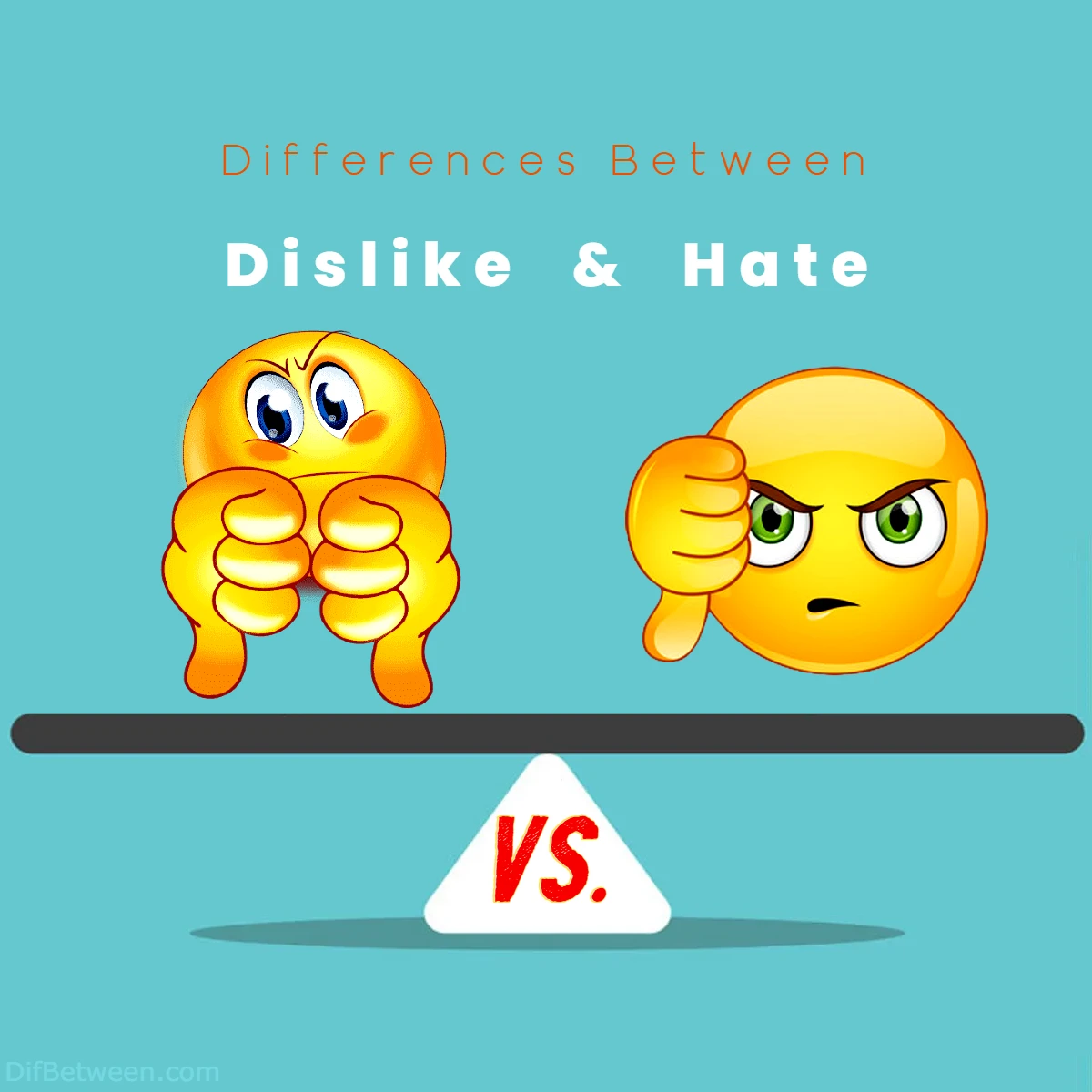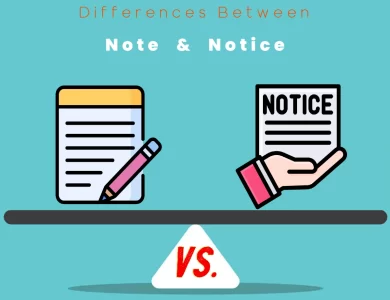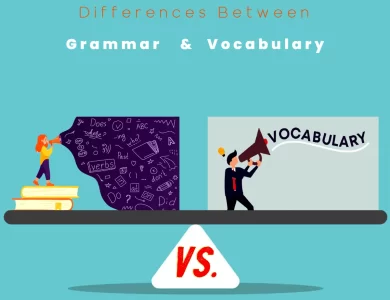
| Aspect | Dislike | Hate |
|---|---|---|
| Intensity | Mild aversion | Intense hostility |
| Emotional State | Discomfort | Loathing and anger |
| Duration | Often temporary | Can be long-lasting |
| Desire for Harm | Rarely involves harm | Often desires harm |
| Common Triggers | Minor annoyances | Deep-seated causes |
| Emotional Impact | Mild | Significant |
| Mental Health Effects | Minimal | Significant psychological strain |
| Physical Health Effects | Negligible | Potential for physical health issues |
| Legal Consequences | Unlikely | Possible and severe |
| Expression | Polite disagreement | Open hostility |
| Verbal Aggression | Rare | Common |
| Physical Aggression | Highly unlikely | Possible and dangerous |
| Social Interaction | Common and manageable | Can lead to discrimination and violence |
| Cultural Impact | Minimal | Significant and potentially harmful |
In this enlightening exploration, we’ll delve into the subtle yet profound disparities that distinguish “dislike” from “hate.” These two emotions may seem like mere shades of negativity, but as we traverse the landscape of semantics and entity-based distinctions, you’ll soon discover their striking dissimilarities.
Differences Between Dislike and Hate
The main differences between “Dislike” and “Hate” lie in the intensity of emotions and their duration. While “Dislike” represents a milder aversion, often stemming from preferences or minor annoyances, “Hate” signifies intense hostility and loathing, often associated with deep-seated grievances or fear. Additionally, “Dislike” is typically temporary and manageable, while “Hate” can persist long-term, leading to significant psychological and even physical health implications. Understanding these distinctions can help individuals navigate their emotions and interactions more effectively.
1. Introduction
Defining Dislike and Hate
Before we dive into the distinctions between dislike and hate, it’s essential to establish clear definitions for these emotions.
Dislike is a relatively mild and common emotional response that arises when someone or something fails to meet our preferences or expectations. It often leads to a sense of discomfort or displeasure but doesn’t typically involve intense animosity or hostility.
Hate, on the other hand, represents a much stronger and hostile emotion. It involves deep-seated anger, resentment, or hostility towards a person, group, idea, or thing. Hatred is characterized by an intense desire for harm or destruction.
Significance of Distinguishing Between Dislike and Hate
Distinguishing between dislike and hate is crucial in our daily lives. It helps us navigate our emotions, make informed decisions, and maintain healthy relationships. When we can identify and label our feelings accurately, we are better equipped to manage them effectively.
Moreover, understanding the differences between these emotions can aid in conflict resolution, empathy development, and personal growth. In this guide, we’ll explore the semantic and entity SEO aspects of dislike vs. hate, shedding light on their unique characteristics and implications.
2. Semantic Differences
Dislike: A Mild Aversion
Disliking something or someone is a common and natural human response. It can stem from various reasons, such as differing preferences, minor annoyances, or simply not feeling a strong connection. When you dislike something, you experience a mild aversion or discomfort.
For instance, you might dislike a particular type of food, a style of music, or a specific movie genre. This dislike doesn’t necessarily consume your thoughts or emotions but can influence your choices and behaviors. You might avoid the disliked food or opt for a different music genre, but it’s unlikely to provoke intense emotions or actions.
Dislike often serves as a compass for our personal preferences and helps us make choices that align with our tastes and values. It’s a relatively benign emotion, usually fleeting and easily managed.
Hate: Intense Hostility and Loathing
Hate, on the other hand, represents a far more severe and toxic emotional state. When you hate something or someone, you harbor intense hostility and loathing. This emotion can manifest in various forms, from a deep-seated resentment towards a coworker to an intense hatred for a particular social or political group.
Hate is a consuming emotion, often characterized by an overwhelming desire for harm or destruction. It can lead to aggressive behaviors, discrimination, and even violence in extreme cases. Unlike dislike, which tends to be situational and temporary, hatred can linger for a long time, poisoning one’s thoughts and actions.
The table below summarizes the key semantic differences between dislike and hate:
| Aspect | Dislike | Hate |
|---|---|---|
| Intensity | Mild aversion | Intense hostility |
| Emotional State | Discomfort | Loathing and anger |
| Duration | Often temporary | Can be long-lasting |
| Desire for Harm | Rarely involves harm | Often desires harm |
| Common Triggers | Minor annoyances | Deep-seated causes |
| Emotional Impact | Mild | Significant |
3. Emotional Impact
Dislike: Irritation and Avoidance
When you experience dislike, the emotional impact is relatively mild. It might lead to feelings of irritation, annoyance, or mild frustration. You might find yourself avoiding the disliked object, person, or situation, but this avoidance is typically driven by a desire to minimize discomfort rather than a deep emotional need to distance yourself.
Dislike often results in a subtle shift in your behavior, such as choosing not to engage with something you don’t enjoy. For example, you might avoid a particular restaurant if you dislike their menu or skip a social gathering if you’re not fond of the people attending. These actions are generally low-key and don’t involve strong emotional turmoil.
Hate: Consuming Negativity and Obsession
Hate, in contrast, exerts a profound emotional impact that can be all-consuming. When you hate someone or something, your thoughts are often dominated by negativity. You may obsessively dwell on the object of your hatred, nurturing feelings of anger, resentment, and even revenge.
This intense emotional state can significantly impact your well-being and mental health. It can lead to sleep disturbances, high levels of stress, and even physical health issues such as hypertension. Hatred has the power to consume your thoughts and actions, often at the expense of other aspects of your life.
The following table summarizes the emotional impact of dislike vs. hate:
| Aspect | Dislike | Hate |
|---|---|---|
| Emotional Impact | Mild irritation and avoidance | Consuming negativity and obsession |
| Mental Health Effects | Minimal | Significant psychological strain |
| Physical Health Effects | Negligible | Potential for physical health issues |
4. Duration and Persistence
Dislike: Often Temporary
Dislike is typically a transient emotion. It arises in response to specific situations or stimuli and tends to fade over time. For example, you might dislike a temporary change in your routine, but as you adapt or the situation resolves, the feeling of dislike dissipates.
Because dislike is often tied to specific circumstances or preferences, it doesn’t usually persist for an extended period. It’s more like a passing cloud than a long-lasting storm.
Hate: Lingering Resentment
Hate, on the other hand, can linger for a very long time. It often involves deep-seated resentment, which can be rooted in past experiences or deeply held beliefs. Hatred may persist for years, if not a lifetime, if left unaddressed.
This prolonged duration can have profound consequences, both for the individual harboring the hatred and for those who are its targets. It can lead to grudges, vendettas, and even intergenerational conflicts if not actively managed and resolved.
The table below highlights the differences in the duration and persistence of dislike and hate:
| Aspect | Dislike | Hate |
|---|---|---|
| Duration | Often temporary | Can persist long-term |
| Rooted in Past | Less likely | More likely |
| Resolution | Easily resolved | Requires active effort |
5. Triggers and Causes
Dislike: Triggers Vary, Typically Non-Severe
Dislike can be triggered by a wide range of factors, and the triggers are often situation-specific. For example, you might dislike a rainy day because it inconveniences your outdoor plans, or you might dislike a particular book because it doesn’t align with your literary preferences.
These triggers are generally non-severe and don’t involve deep emotional wounds. Dislike arises from preferences and minor annoyances rather than profound, traumatic experiences.
Hate: Deep-Seated Causes and Intense Triggers
Hate, on the other hand, usually has deep-seated causes. It can be rooted in experiences of injustice, discrimination, or harm inflicted by others. Hate often arises from a sense of threat, fear, or deep ideological differences.
The triggers for hate can be intense and emotionally charged. It might take very little to provoke hatred towards a person or group if there is a history of conflict or animosity. Hate is often fueled by negative stereotypes, prejudice, or a perceived threat to one’s values or identity.
The table below summarizes the differences in triggers and causes of dislike vs. hate:
| Aspect | Dislike | Hate |
|---|---|---|
| Triggers | Varied and situation-specific | Intense and emotionally charged |
| Causes | Minor annoyances | Deep-seated grievances and fear |
| Rooted in Past | Less likely | More likely |
6. Expression and Communication
Dislike: Polite Disagreement
When it comes to expressing dislike, people often choose a more polite and restrained approach. Disliking something doesn’t necessarily require open confrontation or hostility. Instead, individuals may politely express their disagreement or preference for something else.
For example, if someone offers you a dish you dislike, you might decline it politely, saying that you have a different taste or are not in the mood for it. This allows for social harmony and avoids unnecessary conflicts.
Hate: Open Hostility
Hate, on the other hand, is typically expressed with open hostility. Those who harbor hatred are more likely to confront the object of their hatred directly, engage in verbal or physical aggression, or actively seek to harm or undermine the target.
Hate speech and hate crimes are extreme examples of how hatred can be openly expressed. Such actions can have severe legal and social consequences because they pose a threat to the safety and well-being of individuals or groups.
The following table highlights the differences in expression and communication between dislike and hate:
| Aspect | Dislike | Hate |
|---|---|---|
| Expression | Polite disagreement | Open hostility |
| Verbal Aggression | Rare | Common |
| Physical Aggression | Highly unlikely | Possible and dangerous |
7. Health Implications
Dislike: Mild Stress
Disliking something or someone may lead to mild stress or discomfort, but the overall health implications are usually minimal. The stress associated with dislike is typically short-lived and doesn’t pose a significant risk to one’s physical or psychological well-being.
Mild stress caused by dislike can even have some positive effects, such as encouraging individuals to seek alternative solutions or make healthier choices in their lives.
Hate: Significant Psychological and Physical Health Risks
Hate, on the other hand, can have severe health consequences. The intense negative emotions associated with hatred can lead to chronic stress, which is known to increase the risk of various health issues, including cardiovascular problems, immune system suppression, and mental health disorders such as depression and anxiety.
Moreover, acting on feelings of hatred, such as engaging in hate crimes or seeking revenge, can lead to legal repercussions and further escalate the emotional and health consequences.
The table below summarizes the health implications of dislike vs. hate:
| Aspect | Dislike | Hate |
|---|---|---|
| Psychological Stress | Mild | Significant |
| Physical Health Implications | Minimal | Potential for serious health issues |
| Legal Consequences | Unlikely | Possible and severe |
8. Social and Cultural Context
Dislike: Common Social Interaction
Disliking something or someone is a normal part of social interaction. People have different tastes, preferences, and opinions, and it’s common to encounter situations where you don’t share the same likes or interests with others. In such cases, expressing your dislike politely is often acceptable and doesn’t lead to significant social consequences.
Dislike doesn’t necessarily impact one’s ability to coexist or collaborate with others, as long as it is managed with respect and consideration for differing viewpoints.
Hate: Can Lead to Discrimination and Prejudice
Hate, when left unchecked, can lead to discrimination, prejudice, and even violence. It can create divisions within societies and fuel conflicts between groups with opposing beliefs or identities.
Hate-driven actions, such as discrimination based on race, religion, or gender, have far-reaching social and cultural consequences. They can perpetuate inequalities, marginalize vulnerable populations, and disrupt social harmony.
The following table summarizes the social and cultural implications of dislike vs. hate:
| Aspect | Dislike | Hate |
|---|---|---|
| Social Interaction | Common and manageable | Can lead to discrimination and violence |
| Cultural Impact | Minimal | Significant and potentially harmful |
9. Coping Strategies
Understanding the differences between dislike and hate is crucial, but it’s equally important to learn how to cope with these negative emotions effectively. Here, we’ll explore strategies for managing both dislike and hate.
Coping with Dislike
Acknowledge Your Feelings
The first step in coping with dislike is to acknowledge your feelings. It’s perfectly normal to have preferences and dislikes, and denying or suppressing these emotions can lead to frustration or inner conflict. Accept that you have a right to your feelings.
Identify Triggers
Try to pinpoint the specific triggers of your dislike. Understanding why you feel this way can help you address the root causes and make informed choices. Is it the situation, a particular aspect, or a past experience influencing your feelings?
Communicate Respectfully
If your dislike is related to a person or situation you need to address, communicate your feelings respectfully. Express your concerns or preferences without resorting to hostility or negativity. Constructive communication can lead to positive resolutions.
Seek Alternative Solutions
Instead of dwelling on what you dislike, focus on finding alternative solutions or choices. This proactive approach can empower you to make decisions that align better with your preferences and values.
Coping with Hate
Self-Reflection
Hatred often reflects deeper inner turmoil. Take time for self-reflection to understand why you feel this way. Are there past traumas or unresolved issues contributing to your hatred? Seek professional help if necessary.
Empathy and Perspective
Try to put yourself in the shoes of the person or group you hate. Empathy and perspective-taking can humanize them, making it easier to understand their point of view and potentially find common ground.
Limit Exposure
If a particular source or situation is fueling your hatred, consider limiting your exposure to it. This might involve distancing yourself from toxic environments, social media, or individuals who exacerbate your negative emotions.
Seek Support
Don’t hesitate to seek support from friends, family, or mental health professionals. Talking about your feelings can provide emotional relief and guidance on how to cope with hatred in a healthy way.
Conclusion
In summary, while dislike and hate both represent negative emotions, they differ significantly in terms of intensity, duration, emotional impact, triggers, expression, health implications, and social consequences. Recognizing these differences is essential for managing our emotions, fostering empathy, and maintaining healthy relationships in our personal and societal lives.
It’s important to remember that emotions are a natural part of the human experience, and experiencing dislike or even hate at times is not uncommon. What matters is how we choose to address and manage these emotions. Developing emotional intelligence, seeking resolution through communication and understanding, and promoting tolerance and inclusivity are essential steps towards a more harmonious and compassionate world.
FAQs
The primary difference lies in the intensity of emotions. “Dislike” represents a milder aversion often related to preferences or minor annoyances, while “Hate” signifies intense hostility and loathing, typically rooted in deep-seated grievances or fear.
Yes, it’s possible to experience both “dislike” and “hate” for the same thing or person, though they represent different degrees of negativity. “Dislike” may precede or accompany “hate” as the emotions intensify over time.
Yes, there can be health implications. “Hate” is more likely to lead to significant psychological and physical health issues due to its intensity and persistence. “Dislike” may cause mild stress but typically has minimal health impact.
Coping strategies vary, but acknowledging your feelings, identifying triggers, and seeking support (especially for “hate”) are important. For “dislike,” finding alternative solutions and polite communication can be effective. For “hate,” self-reflection and empathy can help promote understanding and resolution.
“Hate” can lead to discrimination, prejudice, and even violence, contributing to societal conflicts and divisions. “Dislike” is a common part of social interaction and usually doesn’t have significant societal implications unless it escalates into “hate.”
Yes, both “dislike” and “hate” are part of the range of human emotions. They often arise in response to various stimuli, experiences, or differences in preferences and values.
While changing one’s emotions entirely may be challenging, it is possible for emotions to evolve over time with self-awareness and conscious efforts. “Hate” can potentially mellow into “dislike” through understanding and resolution, and “dislike” can sometimes intensify into “hate” if negative experiences persist.
Read More:
Contents






